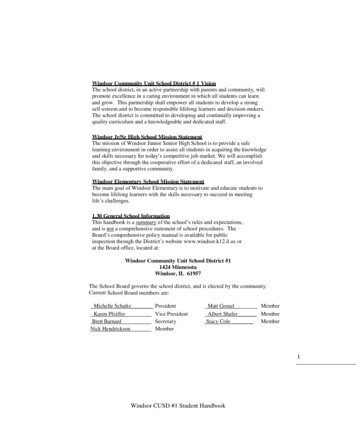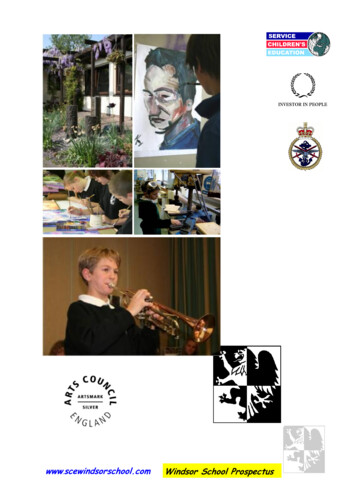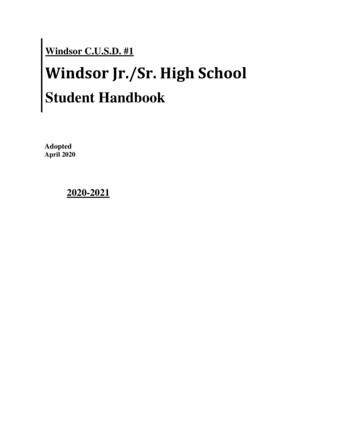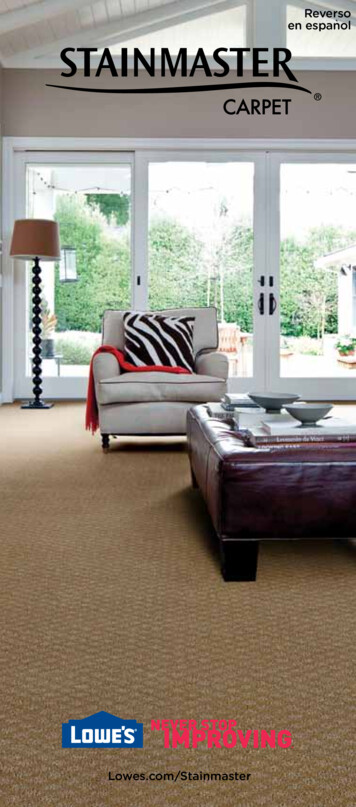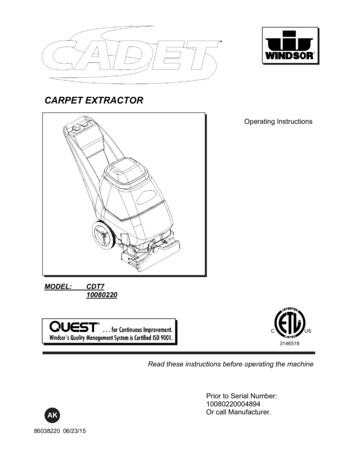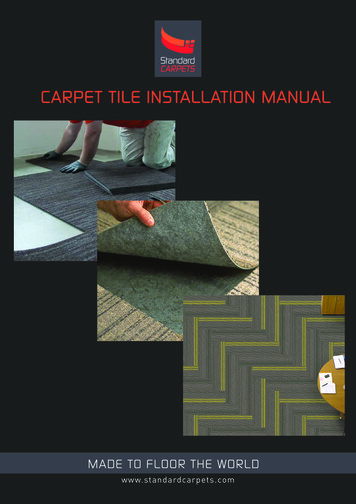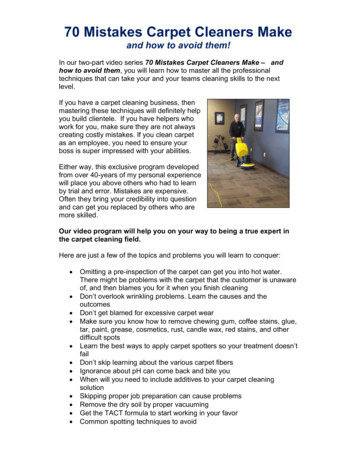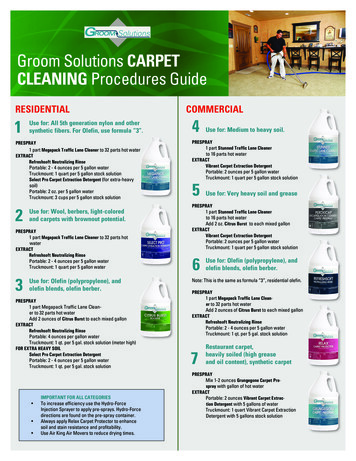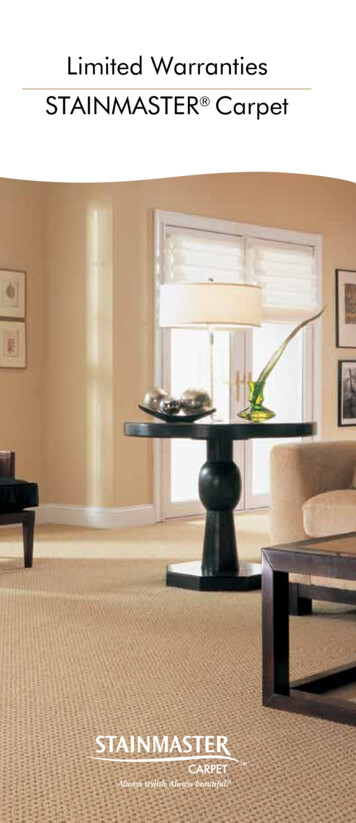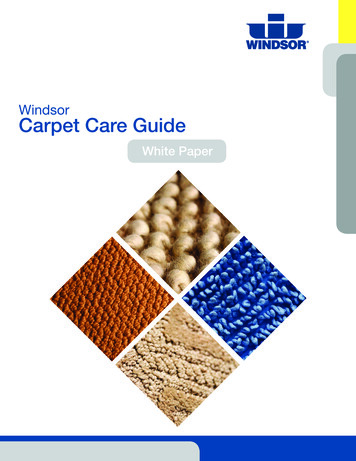
Transcription
WindsorCarpet Care GuideWhite Paper
How carpet is producedCarpets are produced from fibers that can be made from either natural or synthetic materials. Naturalmaterials, such as wool, cotton, and jute are extremely absorbent and tend to dry much slower than theirsynthetic counterparts. Additionally, natural fibers need to be cleaned with lower pH products since leavingthem wet for extended period of time or at a high pH can cause the natural fibers to “brown out” as theyrelease a brown substance that wicks to the tops of the fibers. Today these fibers aretypically encountered in rugs and woven goods in ballrooms and hotels. It is always agood idea to check to see what type of fiber you will be cleaning as permanent damagecan be done to natural fibers that are cleaned improperly.Synthetic fibers are produced from small plastic pellets that are melted down andextruded through a “spinnerette” that somewhat resembles the shower head in yourshower. The fibers are cooled, stretched, and crimped to give them bulk and resiliency.This type of fiber is referred to as “Bulk Continuous Filament” or“BCF”, it is essentially one fiber that is miles long with no breaks.The individual fibers can then bundled together with 50 to 80 otherfibers into what is referred to as a “singles yarn” and wound ontolarge cones. The next step is to take the singles yarns and combinethem with 2 to 4 other singles yarns to produce a yarn that can beused to manufacture a carpet. The fibers are twisted together in a process called “plying”,resulting in a 2, 3, or 4 ply yarn. This type of process is the most common process forproducing commercial carpet.Another type of fiber production process occurs after the fibers have been stretched, cooled, and crimped.In this process the fibers are cut into 6 to 8 inch lengths and processed into a singles yarn. This processrequires a few more steps to blend, straighten, and align the fibers but results in a softer, bulkier fiber thatis more commonly used for residential applications. This process is used for all natural fibers as there isno way to process those types of fibers since they are removed from plants or sheared from sheep. A byproduct of using this type of fiber is that the carpet will have a tendency to “shed” fibers, dramatically atfirst, during it’s life. This is a natural occurrence and will lessen over time.Once the fiber has been produced it can become a carpet through a variety of methods,however the most common are weaving and tufting. Woven carpets are produced on aloom by weaving the face fibers into the warp & weft yarns that make up the backing ofthe carpet. This process is costly and time-consuming. Therefore, these carpets make upabout 1% of all the carpets produced today.The most common carpet production method is tufting. Tufting is accomplished by feeding spools of yarn into a machine that resemblesa giant sewing machine. The fiber is then stitched into the “primarybacking”, which is usually made from olefin fibers, that acts as abase-cloth to hold the fibers in place. The quality of the carpet isdetermined by 3 factors:Stitch Rate The time between the needle penetrations. The faster the needles move the closer the rows.Tufting machines can accommodate anywhere from Gauge 800to 2000 needles. The more needles the closer the stitchesPile Height How far the needle penetrates and how long eachfiber is.When the carpet is tufted into the backing the machine can either hold and release the fiber creating a loop,and thus a “loop pile” carpet or have the loop rock back against a knife, thus creating a “cut pile” carpet.While cut pile carpets are traditionally specified in residential applications for their asthetics and soft feel,commercial applications traditionally specify loop pile carpets for their durability. Some of the most popularstyles of cut pile carpet are Saxony, which has loosely twisted yarns and a plush pile and Frieze, which hasa tightly twisted yarn and resembles a shorter, more modern shag carpet.2
Loop pile carpets are the most popular fibers for commercial applications asthey wear much better in higher traffic situations than cut pile carpets. Themost popular style of loop pile carpet is “level loop” where all the loops arethe same height. Other styles of loop pile carpet, such as “bi-level loop” and“loop and cut pile” carpets are usually installed with appearance and designof the space in mind.Once the carpet has been tufted into the primary backing the next step isapplying a secondary backing that is coated with latex to provide dimensionalstability. Lastly, stain protectant finishes are applied and the carpet is dried,packaged, and shipped.The dyeing of the carpet can be accomplished througha variety of methods. The fibers can be died when theyare extruded, which is called “solution dyeing”. In thisprocess the color pellets are mixed in with the polymer,melted, and then extruded. This results in a fiber that iscolorfast as it has the color all the way through the fiber.The fibers can also be dyed before they are plyed in toyarns or they can be left undyed and tufted into carpetswhich produces a carpet that is essentially white, yetis called a “greige good” (pronounced “Gray”). Once agreige good is produced it can be dyed in a hot bath,or “beck” of dye or run through a continuous dyeingprocess where thousands of feet of carpet can dyed inone step. Both of these processes result in a carpet ofone single color.FriezeSaxonyLevel LoopBi-Level LoopLoop and Cut PileMany carpets, however, are dyed with bright, vibrant patterns and these are producedthrough “print dyeing”. In this process the greige good is run through what in essenceis an extremely large ink-jet printer. The pattern is applied, the ink is set and excessinks are rinsed away. This is a very cost effective method for producing carpets todayand is very popular.Once the carpet has been produced it needs to be installed. Contrary towhat many installers might say there are guidelines for how carpets are to beinstalled and they can be found at www.carpet-rug.com. Look for “CRI-104”for commercial installations and “CRI-105” for residential installations.While you may be familiar with a tackless installation in your home wherethe tackless strips are nailed to the floor and the carpet is stretched of thetacks, a commercial installation is different. In a commercial installation thecarpet is typically glued down to the floor. The glue is applied to the floor witha trowel, allowed a few minutes to set-up and get tacky, and the carpet isrolled over the glue and set in place. This type of installation is called a “directglue” installation. A not to common variant of this type of installation is called“double glue down”. In this method a thin rubber pad is glued to the floor andthen the carpet is glued to the pad to provide more cushion.Lastly, a popular method for commercial installations today is modular tiles. Available in 12” to 36” sizesthese tiles are applied to the floor with a releasable adhesive that allows them to be removed for cleaningor if a stain will not come out.3
Notes4
Understanding the need forcarpet maintenanceTo begin to understand carpet maintenance we must first begin with understandingcarpet. The first carpets, which were rugs crafted from wool, were introduced hundredsof years ago. The wall-to-wall carpeting that we are familiar with came about with thedevelopment of nylon fiber in the late 1930’s and became popular for carpeting in the1950’s. The first generation of carpet fibers were round, which presented a uniqueproblem that the engineers did not expect. While the wool fibers that had been usedfor years to make area rugs had amazing soil hiding properties, the round nylon fibersthat were being used in the new wall-to-wall carpeting actually magnified the soil in thecarpet, causing the carpet to look much more soiled than it actually was.Today’s tri-lobal Carpet FibersThis was obviously an issue for the fiber manufacturers, after all, who wants a carpet thatlooks dirty? So the first change that was made to the carpet fibers, bringing about the“second generation” of carpet fibers was to change to shape of the fibers to a triangularor square shape. This change is the shape of the fiber gave the fiber tremendous soilhiding capabilities, and is the source of many of the challenges we face today. Whilecarpet fibers today are on their fifth generation with carbon fiber filamentsfor static protection, flourochemical protectants for soil and stain blocking,and acid dye blockers to resist stains from popular beverages today, thischange in the shape of the fiber is a source of many issues.While consumers choose carpet for many of its benefits, such as aesthetics,slip resistance, and comfort to name a few, not many will consider carpetseffect on soils in a building. The floor in a building is the largest horizontalsurface and traps the most particulate matter from the air. Additionally,textile surfaces, such as carpet, trap and hold soils from shoes as they enterWool fibers under a microscope. Noticethe cuticles which allows the fiber to hidethe building. This soil trapping and holding ability allows carpeting to have& release soils easily.a positive role in the indoor air quality of a building, if properly maintained.More and more we are finding ourselves becoming “indoor creatures” andtoday we spend on average about 90% of our time indoors in air that can be up to 5 times more pollutedthan the outdoor air. While carpets ability to trap soil plays a positive role in indoor air quality, it still mustbe maintained properly, and this is where the trouble is. Many facility managers are used to the mindset ofcleaning when a surface or an area looks dirty. Hard floors get polished or stripped and refinished when theylook dirty. Concrete gets pressure washed when it looks dirty. The carpet gets cleaned when it looks dirty.The problem is that carpet is engineered to hide soil. So, if carpet is designed to hide soil, and it only getscleaned when it looks dirty, how dirty is it really? It is filthy!NEWCarpet ConditionGOODThis chart shows thedifference between aproper maintenanceprogram and one thatshows the affects ofcleaning when thecarpet looks dirty.FAIRRegular MaintenanceProgramPOORCarpet CleanedNo MaintenanceProgramUnacceptable appearance level, carpet uglies outBAD612182430364248Time In Months5
Furthermore, the soils that accumulate in the pile of the carpet are abrasive and scratch the carpet fiberswith the effect of 120 grit sand paper. This scratching effect permanently damages the fibers and makingthem look dirty all the time. The end result of this scratching is traffic lanes that develop, and damagecannot be corrected by cleaning. Often cleaners find themselves claiming victory over this discolorationafter a night of cleaning when the carpet is still wet. The water left in the carpet fills in the scratches andreflects the light with the appearance of a new carpet fiber. However, once the water has dried the resultis that the traffic lanes will be back.The EPA estimates that we throw away approximately 4.7 billion pounds of carpet every year. That isenough to fully carpet 219 shopping malls. While some of this carpet is truly worn out, the vast majorityis still thrown away because it has “uglied out” and just does not meet the appearance expectationsof the user anymore. This carpet takes about 1000 years to degrade in a landfill since it is typically100% synthetic material. The toll that this takes on our environment is staggering. Thus, theneed for a proper carpet care program.A proper carpet care program will affect not only the environment as a whole, butthe indoor environment and the bottom line as well. A proper carpet care programextends the useful life of the carpet while maintaining a high appearance level,and reducing water usage and dumping of chemicals. A properly maintainedcarpet reduces indoor pollutants and allergies because of its particle trappingeffect. Lastly, a properly maintained carpet reduces overall costs of operation.In a study cited by the carpet manufacturer Lees Carpets, State Farm dida 10 year study with two similar buildings and found that more regularmaintenance, which resulted in higher cleaning costs, saved approximately16% over the lifetime of the carpet because it extended the life of thecarpet. Even though they doubled their cost of cleaning per year they stillsaved in the long run.Which brings us to a proper carpet care program, what is it? A propercarpet care program consists of the following eInterimMaintenanceDeep CleaningMaintenance
Notes7
Preventative MaintenanceLet’s begin with preventative maintenance. Stopping the soil from enteringthe building is the key, as some industry studies estimate that as much as94% of the soil in a facility was tracked in from outside. The more soil westop from entering the building the less we have to clean. So the first step topreventative maintenance is making sure that parking lots and walkways areswept and free of debris that could be tracked into the facility. Additionally,parking lots should be pressure washed on a regular basis to remove oils thataccumulate from atmospheric pollutants, leaking cars, and other sources,so that it is not tracked into the building.Furthermore, proper matting should be installedat all entrances. Industry research has shown that 12 feet ofmatting removes approximately 80% of the soil from shoesand 36 feet of matting removes approximately 99%, so themore matting that can be installed the more effective yourpreventative methods are going to be. A proper mattingsystem is typically comprised of a bi-level scraping matoutside to scrape large particles from the feet, and acarpet type mat inside to wipe and dry the feet. These matsshould be vacuumed, extracted, and maintained as oftenas the carpets are maintained, if not more frequently. Keepin mind that during rain, snow, or other wet conditions the soil load coming into abuilding can triple!PreventativeMaintenanceTool Box Sweepers forparking lots& walkwaysscraping Bi-levelmats for outsideto remove largedebris fromshoesDaily MaintenanceDaily maintenance consists of vacuuming and spotting. The carpetsshould be vacuumed on a regular basis, even though not all areas havethe same vacuuming needs. For example, a carpeted lobby that receives traffic all day longwill need vacuumed much more frequently than a carpet in an office at the back of thebuilding on a high floor. The soil load on the carpet is just not the same. The lobby carpet istaking the brunt of the soil and the soil has walked off the shoes and been deposited longbefore the shoes reach the office.So, not only do different areas require different frequencies of maintenance, but alsodifferent products. High traffic lobbies may need an efficient dual motor vacuum whileoffices may need a single motor upright. Medium traffic hallways may need a wide areavacuum. Keep in mind that there are two types of soil in carpet: unbonded, dry soilswhich can be vacuumed out of the carpet, and bonded, sticky soilswhich are stuck to the fibers and must be cleaned out. Based onindustry research by CW Studer the dry, un-bonded soils compriseapproximately 79% of the soils in the carpet while the bonded,sticky soils comprise approximately 21% of the soils.Sensor singlemotor uprightsThe un-bonded soils are best removed in a dry state throughvacuuming. Based on the fact that 79% of the identifiable soils in carpet aredry in nature vacuuming is the most important step in carpet care. Vacuumingshould be done on a regular basis to remove these soils and should be performedbefore any wet cleaning process is undertaken, such as extraction and encapsulation.Long story short: dirt and water make mud!Spotting should be performed on a daily basis, since nothing catches the eye of a guestlike a stain in the carpet. When spotting always pre-test spotters in an inconspicuousarea for color removal. When trying to determine the correct spotter to use try puttingthe chemical on a Q-tip. This allows the technician to tamp the spot with the Q-tipVersamatic Plus dual motor uprights8
looking for any cleaning effect or color transferwithout completely saturating the spot with thewrong chemical.Keep in mind that chemical should be appliedsparingly, whatever goes in must come out orthe chemicals left in the carpet will cause a spot.Apply just enough chemical to remove the spot,rinse with neutralizing rinse or water and tampdry. This will prevent spots from re-occurring.An understanding ofthe pH scale is importantin spotting, here aresome key facts: Chemicals with a pH of 0-7are called “acids”Spotting ExtractorDaily Maintenance Tool Boxmotor Singlevacuumarea Widevacuum formotor Dualvacuum for hightraffic areas TowelsSafety equipmentlarge, open areas Wet floor signs Spotting kit Spotter extractor Tamping brushChemicals with a pH of 7-14are called “alkalines”7 is neutralYou neutralize acids withalkalines and alkalines withacids For specific spots see thespotting chart in the back ofthe guideInterim MaintenanceInterim maintenance is best accomplished through encapsulation cleaning.Encapsulation cleaning is the process whereby a solution is lightly sprayed onto thecarpet and is then agitated and distributed through the carpet pile by a dual counterrotating brush machine. The chemical is allowed to dwell in the carpet and come incontact with the bonded soils that are stuck to the fibers. Once in contact with thesoil in a liquid state the encapsulation solution pulls the soil from the carpet fiberand into suspension within the encapsulation molecule. Once insuspension the chemical dries into a non-sticky, flaky, crystalthat can be easily vacuumed up during the nextscheduled vacuuming.InterimMaintenanceTool BoxFrom application to dried product takes approximately20 to 30 minutes. This process not only restores carpet toa usable state rather quickly, but it cuts down water andchemical usage, as well as costs. While many chooseto vacuum daily and extract frequently, a good programof scheduled encapsulation can extend the need toextract out 6, to 12, to even 18 months dependingon the area of your facility. For customers looking tolower their costs and increase the appearance level oftheir carpet this is often the key ingredient that theyare missing. Not only is this time saving process goodfor the customer’s bottom line, with reduced water andchemical usage it is good for the environment as well!Encapsulation machine Pump sprayer VacuumiCapsol Mini Deluxe9
Deep CleaningThe goal of deep cleaning maintenance is to remove the deeply embedded soils formthe carpet and return it as close as possible to a “like new” state. Normally, this processinvolves filling an extractor with alkaline extraction chemical and extracting the carpet.However, there are a number of flaws with that process.5First, the chemical needs time in contact with the bonded soils that are stuck to thecarpet fibers, which is commonly referred to as “dwell time”. It is during this time thatthe real cleaning should take place. This is accomplished by allowing the chemical tobe sprayed on the carpet and have 10 to 15 minutes of time pulling the soils from thefibers into emulsion or suspension so that they are waiting for removal. For virtually allsoiling conditions the pre-spray that is applied should bealkaline in nature so that it can most effectively neutralizethe soils in the carpet, which are typically acidic innature.PrinciplesOf CleaningWhen you perform deep,restorative extraction,always follow the5 principles of cleaning:12310Dry soil removal vacuum.Soil suspension usea good pre-spray andgive the chemical10 – 15 minutes ofdwell time - withoutletting it dry.Extraction extractthe soil with aneutralizing rinse toremove the suspendedsoils neutralize thepH and recover themaximum amountof residual detergent.4Grooming only oncut pile.5Drying this iscritical – get thecarpet dry quickly.Use blowers, ceilingfans and HVAC units.The next step is rinsing the suspended soils out of thecarpet through extraction. For this extraction the customershould use an “acid” or “neutralizing” rinse. While manypeople try to use water, it is terribly ineffective at removingthe residues and soils from the pre-spray. Rinsing with hardwater will only remove about 15% of the residues from acarpet. Rinsing with soft water will remove about 30%. Butrinsing with an acidic or neutralizing rinse will remove over90% of the residues form the carpet. Keep in mind thatthe best extractors only recover about 80 to 85% of thesolution that they spray down, and that solution containssoil-attracting detergents. If left to dry those detergentswill attract soils from the atmosphere and from foot trafficleaving a spot that need to be cleaned.Deep ExtractionTool Boxmotor Singlevacuummotor Dualvacuum for hightraffic areasarea Widevacuum forlarge, open areas Extractor-Box & wandSelf containedWalk behindRidersprayer for Pumppre-sprayor brush Rakefor agitating inprespray Blowers Safety equipment Wet floor signsAfter the carpet has been cleaned and rinsed the last stepis to dry the carpet a quickly as possible. Drying the carpetis important since carpet that stays wet for longer than 8hours becomes a potential breeding ground for mold and the longer the carpetis wet the more chance you have for wicking. To dry the carpet be sure to utilizecommercial blowers, run the HVAC system in the building for atleast 24 hoursafter cleaning, turn on ceiling fans, and leave doors open so air can circulate.If you choose to apply carpet protectants do so before drying the carpet. Applythe protectants at the manufactured recommended application rates for thesquare footage you are protecting.Make certain that no foot traffic isintroduced to that area till the carpetis completely dry, as this will reducethe effectiveness of the protectantin those areas. When applying theseNu Waveproducts always use an electric sprayerWide Area Vacuumthat generates consistent pressure foreven application. Pump-up sprayerslose pressure as soon as you startspraying and are not a good choice forthis application. Lastly, make sure thatthe sprayer that is utilized is a dedicatedsprayer since leftover chemicals couldinterfere with the protectants ability tobond and protect the carpet.
Notes11
Bold Innovation. Expert Results.Windsor Industries, Inc.1351 West Stanford AvenueEnglewood, Colorado 80110 U.S.A.800.444.7654303.762.1800303.865.2800 (fax)www.windsorind.comWindsor Innovations Protect: 2008 Windsor Industries, Inc.All rights reserved.Indoor Air QualityWaterPeopleEnvironmentA-573
after a night of cleaning when the carpet is still wet. The water left in the carpet fills in the scratches and reflects the light with the appearance of a new carpet fiber. However, once the water has dried the result is that the traffic lanes will be back. The EPA estimates that we throw away approximately 4.7 billion pounds of carpet every year.
